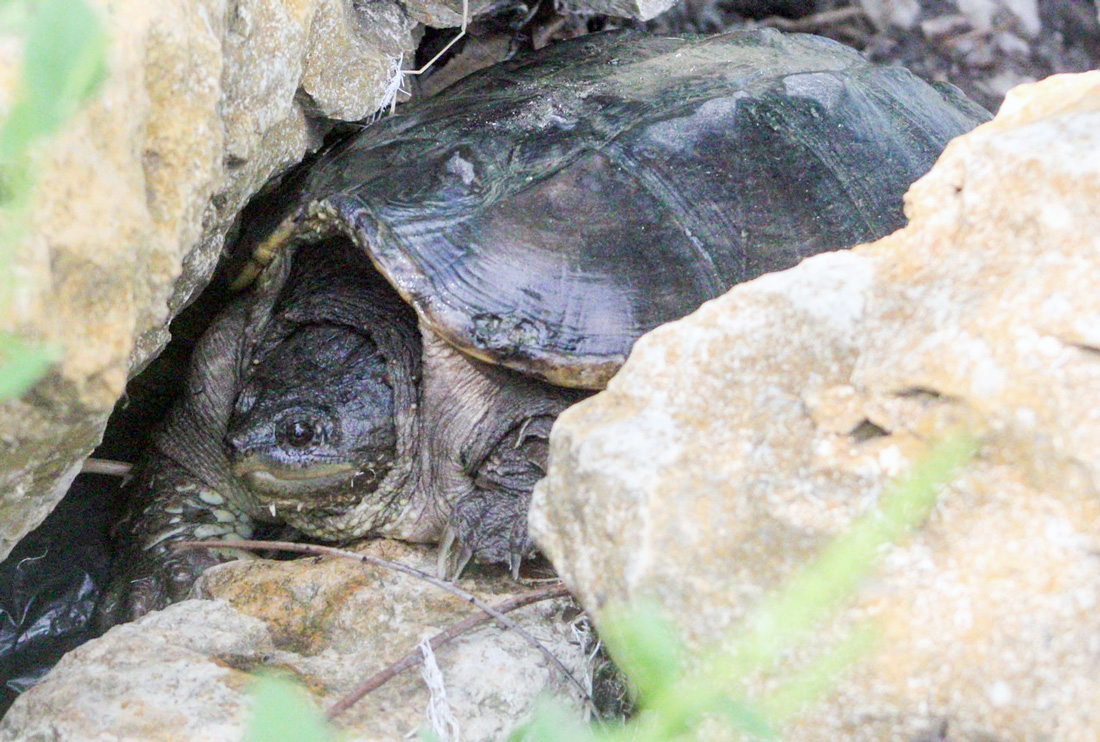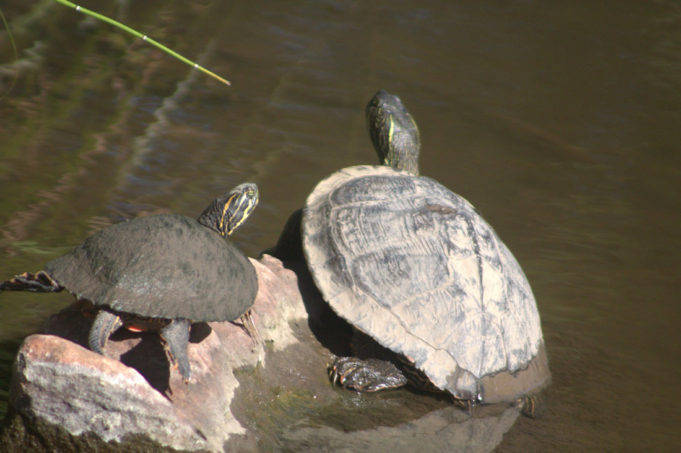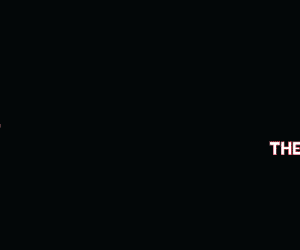At a Fort Worth pond, I seek turtles. Red-eared sliders and flat gray pancakes of spiny softshells plop into the water when I’m too close. I do not want to disturb them sunning themselves, gathering heat into their scales. Reptiles are cold-blooded, a phrase connotative with emotionless psychopaths, though a more accurate word is “ectotherm,” meaning they acquire warmth from outside sources like the sun or hide in water or shade to avoid overheating. Turtles resemble circular green monks, mystics of patience for heat and food, and the words “cold-blooded” cannot do justice to their tender demeanors.
It is September today. June Bugs have died and left jellyful grubs in the soil. Inside a chrysalis, a new heartbeat forms from the genetic slush that caterpillars’ bodies turn to, forging wings. Looking for turtles is a respite for the human world’s petty humiliations: my student debt and the relentless expectation that I am supposed to make money. I made the choice to do what I love, writing and tutoring, instead of selling a product, leaving me poor and estranged from a civilization whose highest value seems to be the bottom line, yet the world preserves itself and spins. Even in this age when pollution and exploitation of the Earth threatens life itself, at least for now, in this pond, I’m thankful the turtles seem content.
There! At last. I see a snapping turtle. A thick springable neck, powerful clawed front feet, and a dragon-like tail indicate the species, the sun twinned in her dark brown eyes. I remember a legend from the Mohawk tribe from New York state, that the entire Earth was a rolling ocean. A flock of swans carried a pregnant woman onto the back of a tremendous sea turtle. Beavers dived into the deep and gave her mud to spread on the turtle’s carapace, thus North America became known as Turtle Island. There are sacred, cosmological motifs of turtles, like the Mohawk’s, and there are modern scientific epics, too.
Evolutionary biology suggests that turtles appeared in the late Triassic about 220 million years ago. Turtles and tortoises belong to the taxonomic order Testudines (formally called Chelonians.) Stout bodies and wily survival strategies sustained these creatures until recently, when pollution, climate change, and habitat loss threaten many species — 187 of 360 of them are in danger, more than half, including six out of seven sea turtles.
Another animal, different from turtles, also depends on the health of their environment to survive: human beings. Yet so many of us live in internal bubbles such as the quest for power, money, and social status that we ignore the surrounding ecosphere that sustains us.
Within our little cloisters of self, it is easy to call saving turtles a mere aesthetic concern, worthy of preservation only because people like them. Instead, turtles’ looming extinction sounds a more urgent alarm: the extinction of life itself. It is not up to us to determine the value of nonhuman life, for reasons like complex civilizations, language, and the scientific method, criteria arbitrated by humans for humans. It’s impossible to deny humanity’s animality. People exist in a non-hierarchical continuum of life from snails to jellyfish to prairie dogs and turtles. Our species depends on bacteria inside our stomachs to digest food, which also comes from other lifeforms, both plant and animal. As Aldo Leopold understood, environmental equilibrium balances on a thin tightrope. Sea turtle eggs provide nutrients to dune plants on the shore, preventing erosion, and the dunes protect human habitats from coastal waters. Freshwater turtles scavenge dead fish and crustaceans, keeping ponds and lakes clean of carrion, including urban reservoirs. To destroy nature for profit is to sell ourselves.

Turtles, humans, toads, birds, snails, dolphins, insects — they all have an equal inheritance to Earth’s bounty, which we kill through deforestation, pollution, and carbon released into the atmosphere with such damage to the balance of global temperature that some scientists now call our geologic epoch the Anthropocene. This naming is not meant to compliment human beings. The presumption that humans are, per Hamlet, “the paragon of animals” permits the exploitation of nature for human ends. The world and the universe were not made for humans alone. Earth spins its tiny blue speck around an average star among a galaxy of 400 billion suns in a cosmos of more than 100 billion galaxies. Outside the human animal, intergalactic vastness spreads its revelation.
Since the Renaissance, Western civilization has enacted relentless natural exploitation. This was based upon a subset of humanistic ideals that rationality defines humanity, exemplified by the philosopher Rene Descartes, who believed animals were merely instinctive robots, reacting to their environment as a lightbulb reacts to an on-switch. Another ideological foundation to human supremacy is a literal interpretation of Genesis 1:26, that people are made in the likeness of God and given dominion over every nonhuman being. As the historian Lynn White discussed in his seminal essay “The Historical Roots of Our Ecologic Crisis,” this dominionist interpretation was adopted by church fathers, despite the alternative theology of Saint Francis of Assisi, the patron saint of animals and ecology. Conquistadors, without asking Native Americans’ permission, asserted their lust for gold and their Catholicism onto the New World. Although containing recent, notable exceptions — namely, Darwinist Jesuit Teilhard de Chardin and the deep ecologist Fr. Thomas Berry — the conquistadors’ religion depicted humans over nonhumans in a divinely ordained hierarchy, The Great Chain of Being, with God over angels, angels over man, and man over beasts. Europe’s mercantilism was built after unsustainable models. Farmland sutured wildlife corridors and imprisoned deer, bears, and boars in diminishing pockets of forest, and Europe’s Atlantic was overfished by Columbus’ time, all while the population rose but resources were distributed unevenly among commoners and nobles. In contrast, the indigenous tribes of the Americas largely based their economies on reciprocity. Hunters gave thanks to the elk they slew. Natives believed that disrespecting bison and other game harmed the natural order to which these creatures belonged and in turn harmed human beings themselves. What’s taken from the environment must be returned to maintain equilibrium, as human beings were part of the same natural order. Natives burned prairies and had an effect on their environment, but it is hard to deny that the ideology of the conquistadors, which divided the human from nature, led to deadlier results.
Global capitalism is perhaps the most radical human construct ever practiced, radical because it is physically unsustainable. The United States largely places a higher value on the abstraction of money than on the concreteness of the physical world. To a bird, a $50 bill may be nesting material. To a person, the value is designated somewhat consistently but arbitrarily. Imagine explaining capitalism to aliens from another planet. We would tell them we work not for our individual benefit, not for the benefit of the Earth or the human species, but to further capital and production, abstract constructs that have no value besides what we’ve given them. I imagine the space creatures would roll their eyes, supposing they had them.
The same logic that exploits nonhumans for profit and power will also exploit humans. Capitalism contains within itself the inevitable conclusion of slavery. We ought to view humans and nonhumans as equally sacred beings, no human endowed with divine preference more than any garden slug. The Earth is our mother. Her sapphire drop glimmers in fathomless cosmic blackness, pale and vulnerable. In “Birches,” Robert Frost wrote, “Earth’s the right place for love: / I don’t know where it’s likely to go better.” What matters beyond personal ambition and societal expectation is the survival of the world. Each hoof-printed plain, mountain peak laureled with snow, moss-sweating pine forest, and desert where snakes writhe through jagged succulents are all cathedrals older than Rome and Egypt. Currently, the global economy steers toward infinite growth, a misnomer for a finite planet. Turtle Island’s new dream must go beyond the old American dream of personal enrichment to maintain the survival of the world.
If North America is Turtle Island, at least metaphorically, this land is not a business opportunity. We have no right to carve up portions of the world for human dominion, as no one truly “owns” land or property in a literal sense. We simply live on it, as do chipmunks, lizards, and spiders. Yet no one attributes property rights to nonhumans. We ought to live for others, including our human and nonhuman neighbors with the least representation. We ought to respect the inherent, non-monetary worth of homeless panhandlers, the incarcerated, chickadees, harvest mice, and turtles in their emerald shells, the muddy jewels of their bodies.
The largest freshwater turtle, the Yangtze giant softshell, can weigh over 500 pounds. Only one captive breeding pair remained in the world. In 2019, when Chinese biologists tried to inseminate the last female of her kind, she died, making the Yangtze giant softshell functionally extinct. There will be babies born in hospitals all over the world. Turquoise robin eggs crack open with squeaking hatchlings. But soon there will never be another Yangtze giant softshell’s heart beating underwater.
For most of us, being the last person on Earth is unimaginable. Many of us assume narcissistically that it does not matter if a turtle goes extinct because “I’m not a turtle.” Yet the proliferation of carbon pollutants, much of which comes from those who now live in the United States, can introduce the process of ecological collapse, where we wake too late from the slumber of our human hubris to realize we are animals, too, subject to the same physical balance that sustains our nonhuman kin.
I took a few pictures of the common snapper, hiding from me between pale shelves of rock, her snout testing my scent, her neck mostly retracted, able to spring an attack that could smash and cut my hand. The snapper might be a female laying her eggs, a cosmic motif of beginnings. Her hatchlings may be born, innocent of the Blakean dark Satanic mills of industrial capitalism, and in the tiny creatures’ innocence, they may be accosted by plastic bags, polluted water, and crimes committed with impunity by people where the turtles are punished.
Astronomers predict that 700 quintillion planets exist in the universe. We know only one such planet with life, people and turtles. One of this planet’s continents paved the way from regressions of monarchy to a government that, to paraphrase Lincoln, is by the people, for the people, and should not perish from the Earth. However, Earth’s survival sustains Turtle Island, even more than human democracy. In this political era tormented by culture wars, we must conserve Turtle Island. People are unmistakably animals and animals with unmistakable freedom. Our species is not at the mercy of biological impulses because we make choices. Americans can live for wealth and comfort, or we can make Turtle Island a republic where politics and economics tend toward the ultimate aim of ecology: survival. We must live authentically, as turtles do, not coveting excess beyond Earth’s bounty. We must live for justice. Above all, we must live.
Experts say poverty, superstition, and social media are driving some species to extinction. Read more in Trafficking Exotics in Creature Comforts 2023.













Another great nature article with photography by Eric Stone!